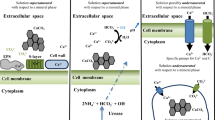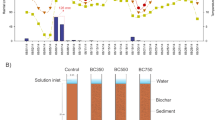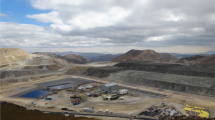Abstract
Growing and intensified mining activities in China have produced substantial quantities of carbonate-bearing tailings wastes. Rapid chemical weathering of these wastes, accompanied by active CO2 fluxes (CO2 absorption and degassing), have the potential to positively or negatively influence the emissions arising from the mining sector. However, few prior studies have examined these processes and effects. Herein, we present a systematic investigation of the chemical and mineral composition, hydro-geochemistry, and isotopes of four tailings ponds and filtrates in Panxi valley, Sichuan province, China. Our results reveal that significant rock–water interactions have occurred in carbonate-hosted tailings with active carbonate and silicate dissolution. The abundance of sulfuric acid in the dissolved load, derived from sulfide oxidation, provides a non-negligible portion of protons for chemical weathering. The influences on cationic weathering, therefore, were found to be carbonic–carbonate weathering > sulfide–carbonate weathering > sulfide–silicate weathering > mineral processing inputs > nature inputs > atmospheric inputs. Exoreic river basin tailings have the potential to fix atmospheric CO2 and provide a valuable strategy toward China’s carbon neutrality goals. However, inland/arid area mining also has the potential to risk net CO2 degassing and hence encumber the mining industry’s carbon performance.


Similar content being viewed by others
References
Al TA, Martin CJ, Blowes DW (2000) Carbonate-mineral/water interactions in sulfide–rich mine tailings. Geochim Cosmochim Acta 64:3933–3948. https://doi.org/10.1016/s0016-7037(00)00483-x
Anderson SP, Drever JI, Frost CD, Holden P (2000) Chemical weathering in the foreland of a retreating glacier. Geochim Cosmochim Acta 64:1173–1189. https://doi.org/10.1016/S0016-7037(99)00358-0
Beaulieu E, Goddéris Y, Labat D, Roelandt C, Calmels D, Gaillardet J (2011) Modeling of water-rock interaction in the Mackenzie basin: Competition between sulfuric and carbonic acids. Chem Geol 289:114–123. https://doi.org/10.1016/j.chemgeo.2011.07.020
Berner OP (1988) The global water cycle geochemistry, and environment. EOS Trans 69:51–51. https://doi.org/10.1029/88EO00043
Blowes D, Ptacek C (1994) Acid-neutralization mechanisms in inactive mine tailings. Environ Geochem Sulfide Mine-Wastes 22:271–292
Booth J, Hong Q, Compton RG, Prout K, Payne RM (1997) Gypsum overgrowths passivate calcite to acid attack. J Colloid Interface Sci 192:207–214. https://doi.org/10.1006/jcis.1997.4978
Burke WH, Denison RE, Hetherington EA, Koepnick RB, Nelson HF, Otto JB (1982) Variation of seawater 87Sr/86Sr throughout Phanerozoic time. Geology 10:516–519. https://doi.org/10.1130/0091-7613(1982)10%3C516:VOSSTP%3E2.0.CO;2
Busenberg E, Plummer LN (1982) The kinetics of dissolution of dolomite in CO2-H2O systems at 1.5 to 65 and 0 to 1 atm CO2. Am J Sci 282:45–78. https://doi.org/10.1016/j.apgeochem.2008.08.011
Charlie YXU, Schwartz FW, Traina SJ (1997) Treatment of acid-mine water with calcite and quartz sand. Environ Eng Sci 14:141–152. https://doi.org/10.1089/ees.1997.14.141
Chen F, Jia G, Chen J (2009) Nitrate sources and watershed denitrification inferred from nitrate dual isotopes in the Beijiang River, South China. Biogeochemistry 94:163–174. https://doi.org/10.1007/s10533-009-9316-x
Chetelat B, Liu C-Q, Zhao ZQ, Wang QL, Li SL, Li J, Wang BL (2008) Geochemistry of the dissolved load of the Changjiang Basin rivers: Anthropogenic impacts and chemical weathering. Geochim Cosmochim Acta 72:4254–4277. https://doi.org/10.1016/j.gca.2008.06.013
Dacal M, Bradford MA, Plaza C, Maestre FT, Garcia-Palacios P (2019) Soil microbial respiration adapts to ambient temperature in global drylands. Nat Ecol Evol 3:232–238. https://doi.org/10.1038/s41559-018-0770-5
Davis KJ, Nealson KH, Lüttge A (2007) Calcite and dolomite dissolution rates in the context of microbe-mineral surface interactions. Geobiology 5:191–205. https://doi.org/10.1111/j.1472-4669.2007.00112.x
Ding L-l, Zhang J, Yin X (2019) Multi-objective programming model for enterprise decision-making under the interaction of progressive carbon tax and carbon trading. Adv Econ Bus Manag Res 106:118–121. https://doi.org/10.26914/c.cnkihy.2019.057387
Gaillardet J, Dupré B, Louvat P, Allegre CJ (1999) Global silicate weathering and CO2 consumption rates deduced from the chemistry of large rivers. Chem Geol 159:3–30. https://doi.org/10.1016/s0009-2541(99)00031-5
Gaillardet J, Millot R, Dupré B (2003) Chemical denudation rates of the western Canadian orogenic belt: the Stikine terrane. Chem Geol 201:257–279. https://doi.org/10.1016/j.chemgeo.2003.07.001
Gaillardet J, Calmels D, Romero-Mujalli G, Zakharova E, Hartmann J (2019) Global climate control on carbonate weathering intensity. Chem Geol 527:118762. https://doi.org/10.1016/j.chemgeo.2018.05.009
Gautelier M, Oelkers EH, Schott J (1999) An experimental study of dolomite dissolution rates as a function of pH from −0.5 to 5 and temperature from 25 to 80 °C. Chem Geol 157:13–26. https://doi.org/10.1177/0144598717751927
Guan D (1998) Orebody shape change and prospecting target of Tiekuangshan iron ore deposit, Lugu, Mianning. Acta Geol Sichuan 18:31–39 (in Chinese)
Han G, Yang T, Xu Z (2010) Fluvial geochemistry of rivers draining karst terrain in Southwest China. J Asian Earth Sci 38:65–75. https://doi.org/10.1016/j.jseaes.2009.12.016
Hayes SM, Root RA, Perdrial N, Maier RM, Chorover J (2014) Surficial weathering of iron sulfide mine tailings under semi-arid climate. Geochim Cosmochim Acta 141:240–257. https://doi.org/10.1016/j.gca.2014.05.030
Jurjovec J, Blowes D, Ptacek C (1995) Acid neutralization in mill tailings and the effect of natrojarosite addition. Min Environ 1:29–38
Jurjovec J, Ptacek CJ, Blowes DW (2002a) Acid neutralization mechanisms and metal release in mine tailings A laboratory column experiment. Geochim Cosmochim Acta 66:1511–1523. https://doi.org/10.1016/s0016-7037(01)00874-2
Jurjovec J, Ptacek CJ, Blowes DW (2002b) Acid neutralization mechanisms and metal release in mine tailings: a laboratory column experiment. Geochim Cosmochim Acta 66:1511–1523. https://doi.org/10.1016/s0016-7037(01)00874-2
Kelemen PB, Matter J (2008) In situ carbonation of peridotite for CO2 storage. Proc Natl Acad Sci 105:17295–17300
Lee KS, Bong YS, Lee D, Kim Y, Kim K (2008) Tracing the sources of nitrate in the Han River watershed in Korea, using δ15N-NO3- and δ18O-NO3- values. Sci Total Environ 395:117–124. https://doi.org/10.1016/j.scitotenv.2008.01.058
Li S-L, Liu C-Q, Li J, Lang Y-C, Ding H, Li L (2010) Geochemistry of dissolved inorganic carbon and carbonate weathering in a small typical karstic catchment of Southwest China: Isotopic and chemical constraints. Chem Geol 277:301–309. https://doi.org/10.1016/j.chemgeo.2010.08.013
Li Z, Liu L, Zhao L, Ji J, Chen J (2011) Carbon dioxide sequestration by ultramafic-hosted mine tailings: example from Jinchuan copper-nickel mine tailing. Quat Sci 31:464–475. https://doi.org/10.3969/j.issn.1001-7410.2011.03.09 (in Chinese)
Li S-L, Chetelat B, Yue F, Zhao Z, Liu CQ (2014) Chemical weathering processes in the Yalong River draining the eastern Tibetan Plateau, China. J Asian Earth Sci 88:74–84. https://doi.org/10.1016/j.jseaes.2014.03.011
Li Y, Sun W, Yang Z (2017) Identification of nitrate sources and transformation processes in the midstream areas: a case in the Taizi River Basin. Environ Sci 38:5039–5046. https://doi.org/10.13227/j.hjkx.201704238 (in Chinese)
Liao C, Shi Z, Wang D, Zhang F, Xu W, Li T (2020) Water chemical characteristics and the substance provenance in Anning River Basin of Sichuan Province. Earth Environ 48:680–688. https://doi.org/10.14050/j.cnki.1672-9250.2020.48.083 (in Chinese)
Lin W, Liao D, Liu Z, Fan H (2012) Analysis of acid rain change and precipitation chemical characteristics in Panzhihua City. J Panzhihua Univ 29:120–123. https://doi.org/10.3969/j.issn.1672-0563.2012.04.036 (in Chinese)
Liu Z (2011) New progress and prospects in the study of rock-weathering-related carbon sinks. Chin Sci Bull 57:95–102. https://doi.org/10.1360/972011-1640 (in Chinese)
Liu C-q, Jiang Y-k, Tao F-x, Lang Y-c, Li S-l (2008) Chemical weathering of carbonate rocks by sulfuric acid and the carbon cycling in Southwest China. Geocchimica 37:404–414. https://doi.org/10.3321/j.issn:0379-1726.2008.04.014 (in Chinese)
Long X, Sun Z, Zhou A, Liu D (2015) Hydrogeochemical and isotopic evidence for flow paths of karst waters collected in the Heshang Cave, Central China. J Earth Sci 26:149–156. https://doi.org/10.1007/s12583-015-0522-2
Millero FJ, Zhang J-Z, Lee K, Campbell DM (1993) Titration alkalinity of seawater. Mar Chem 44:153–165. https://doi.org/10.1016/0304-4203(93)90200-8
Nguyen DH, Chapman A, Farabi-Asl H (2019) Nation-wide emission trading model for economically feasible carbon reduction in Japan. Appl Energy 255:113869. https://doi.org/10.1016/j.apenergy.2019.113869
Palandri JL, Kharaka YK (2004) A compilation of rate parameters of water-mineral interaction kinetics for application to geochemical modeling. U.S. GEOLOGICAL SURVEY, Menlo Park, pp 1–70
Pawellek F, Veizer J (1994) Carbon cycle in the upper Danube and its tributaries: δ13CDIC constraints. Israel J Earth Sci 43:187–194
Peel MC, Finlayson BG, Mcmahon T (2007) Updated world map of the Köppen-Geiger climate classification. Hydrol Earth Syst Sci 11:1633–1644. https://doi.org/10.1127/0941-2948/2006/0130
PMSC (2016) Climatic background analysis of Panzhihua City. Public-Meteorological-Service-Center, Panzhihua, pp 1–3
Ran X, Xu B, Liu J, Zhao C, Liu S, Zang J (2017) Biogenic silica composition and δ13C abundance in the Changjiang (Yangtze) and Huanghe (Yellow) Rivers with implications for the silicon cycle. Sci Total Environ 579:1541–1549. https://doi.org/10.1016/j.scitotenv.2016.11.161
Ryu J-S, Lee K-S, Chang H-W, Shin HS (2008) Chemical weathering of carbonates and silicates in the Han River basin, South Korea. Chem Geol 247:66–80. https://doi.org/10.1016/j.chemgeo.2007.09.011
Schwartzman DW, Volk T (1989) Biotic enhancement of weathering and the habitability of Earth. Nature 340:457–460. https://doi.org/10.1038/340457a0
Sonter LJ, Herrera D, Barrett DJ, Galford GL, Moran CJ, Soares-Filho BS (2017) Mining drives extensive deforestation in the Brazilian Amazon. Nat Commun 8:1–7. https://doi.org/10.1038/s41467-017-00557-w
Sonter LJ, Dade MC, Watson JEM, Valenta RK (2020) Renewable energy production will exacerbate mining threats to biodiversity. Nat Commun 11:1–6. https://doi.org/10.1038/s41467-020-17928-5
Spence J, Telmer K (2005) The role of sulfur in chemical weathering and atmospheric CO2 fluxes: evidence from major ions, δ13CDIC, and δ34SSO4 in rivers of the Canadian Cordillera. Geochim Cosmochim Acta 69:5441–5458. https://doi.org/10.1016/j.gca.2005.07.011
Stumm W, Morgan JJ (1981) Aquatic chemistry. Wiley, Hoboken
Tang L (2017) Inverstigation on the mineralization of tailings with CO2 in the atmosphere. Sichuan University, Sichuan (in Chinese)
Veetil SP, Mucci A, Arakaki T (2018) Dolomite dissolution kinetics in aqueous solutions in the presence of organic and inorganic additives at 25 °C and pCO2 ~ 1 atm. Chem Geol 483:98–110. https://doi.org/10.1016/j.chemgeo.2018.02.025
Veizer J, Bruhn F, Ala D, Godderis Y, Azmy K, Bruckschen P, Carden GAF, Jasper T, Podlaha OG, Diener A, Korte C, Strauss H, Ebneth S (1999) 87Sr/86Sr, δ13C and δ18O evolution of Phanerozoic seawater. Chem Geol 161:59–88. https://doi.org/10.1016/S0009-2541(99)00081-9
Vogeli J, Reid DL, Becker M, Broadhurst J, Franzidis JP (2011) Investigation of the potential for mineral carbonation of PGM tailings in South Africa. Miner Eng 24:1348–1356. https://doi.org/10.1016/j.mineng.2011.07.005
Wang X, Zeng H, Zhong G (2003) Application of footwall cutting technology at lugu iron mine, Sichuan. Metal Mine 323:4–7. https://doi.org/10.3321/j.issn:1001-1250.2003.05.002 (in Chinese)
Wang C, Deng J, Zhang S, Xue C, Yang L, Wang Q, Sun X (2010) Sediment-hosted Pb-Zn deposits in Southwest Sanjiang Tethys and Kangdian area on the Western Margin of Yangtze Craton. Acta Geol Sin (english Ed) 84:1428–1438. https://doi.org/10.1111/j.1755-6724.2010.00338.x
Wilson SA, Dipple GM, Power IM, Thom JM, Anderson RG, Raudsepp M, Gabites JE, Southam G (2009a) Carbon dioxide fixation within mine wastes of ultramafic-hosted ore deposits: examples from the clinton creek and cassiar chrysotile deposits, Canada. Econ Geol 104:95–112. https://doi.org/10.2113/gsecongeo.104.1.95
Wilson SA, Raudsepp M, Dipple GM (2009b) Quantifying carbon fixation in trace minerals from processed kimberlite: a comparative study of quantitative methods using X-ray powder diffraction data with applications to the Diavik Diamond Mine, Northwest Territories, Canada. Appl Geochem 24:2312–2331. https://doi.org/10.1016/j.apgeochem.2009.09.018
World-Bank-Group (2019) Carbon pricing dashboard. World Bank Group, Washington, pp 1–36
Wu P, Liu C-q, Zhang G, Zhu I-j, Yang Y-g (2007) Sulfur isotopic geochemistry of the water system in mine area: a case study of the Hou River in Hezhang County, Guizhou, China. Bull Mineral Petrol Geochem 26:224–227. https://doi.org/10.1016/S1872-5791(07)60044-X (in Chinese)
Xie H, Tang L, Wang Y, Liu T, Hou Z, Wang J, Wang T, Jiang W, Were P (2016) Feedstocks study on CO2 mineralization technology. Environ Earth Sci 75:614–622. https://doi.org/10.1007/s12665-016-5352-8
Yang W, Pan Y, Ma J, Zhou M, Chen Z, Zhu W (2018) Optimization on emission permit trading and green technology implementation under cap-and-trade scheme. J Clean Prod 194:288–299. https://doi.org/10.1016/j.jclepro.2018.05.123
Zeng W, Liu S (1990) Study on application of magnetic/gravity separation process in rich ore of Lugu Iron Mine. Sichuan Metall 2:9–13 (in Chinese)
Zeng S, Liu Z, Goldscheider N, Frank S, Goeppert N, Kaufmann G, Zeng C, Zeng Q, Sun H (2020) Comparisons on the effects of temperature, runoff, and land-cover on carbonate weathering in different karst catchments: insights into the future global carbon cycle. Hydrogeol J 29:331–345. https://doi.org/10.1007/s10040-020-02252-5
Zhang G, Liu CQ, Yang Y, Wu P (2004) Characterization of heavy metals and sulphur isotope in water and sediments of a mine-tailing area rich in carbonate. Water Air Soil Pollut 155:51–62. https://doi.org/10.1023/B:WATE.0000026517.71668.0b
Zhang Y, Liu T, Zhang J (2008) Research on properties and beneficiation process for tianbaoshan copper-lead-zinc polymetallic ore. Met Mine 383:70–73. https://doi.org/10.3321/j.issn:1001-1250.2008.05.019
Zheng Y, Chen J (2000) Stable isotope geochemistry. Science Press, Beijing
Zhou J, Mao Y, Luo S (1990) Tectonic ore-controlling characteristics of Lake iron ore in Xide county, Sichuan province. J Chengdu Univ Technol 11:18–30 (in Chinese)
Acknowledgements
The authors thank Michael Z. Hou (Technische Universität Clausthal, Germany) and Jingsong Yang (Institute of Hydrogeology and Environmental Geology, Chinese Academy of Geological Sciences, China) for discussions on an earlier version of the manuscript. Additionally, we thank the Qinping Tan for assistance with field investigations (Institute of Geochemistry, Chinese Academy of Sciences, China). This work was funded by the National Key R&D plan project from the Ministry of Science and Technology of the People’s Republic of China (2016YFC0600604).
Author information
Authors and Affiliations
Corresponding author
Ethics declarations
Competing interests
The authors have no relevant financial or non-financial interests to disclose.
Additional information
Publisher's Note
Springer Nature remains neutral with regard to jurisdictional claims in published maps and institutional affiliations.
This article is part of a Topical Collection in Environmental Earth Sciences on Earth Surface Processes and Environment in a Changing World: Sustainability, Climate Change and Society, guest edited by Alberto Gomes, Horácio García, Alejandro Gomez, Helder I. Chaminé.
Supplementary Information
Below is the link to the electronic supplementary material.
Rights and permissions
Springer Nature or its licensor holds exclusive rights to this article under a publishing agreement with the author(s) or other rightsholder(s); author self-archiving of the accepted manuscript version of this article is solely governed by the terms of such publishing agreement and applicable law.
About this article
Cite this article
Sun, L., Werner, T., Yang, F. et al. CO2 fluxes in the chemical weathering of carbonate-hosted tailings ponds, Panxi valley, Sichuan province, China. Environ Earth Sci 81, 392 (2022). https://doi.org/10.1007/s12665-022-10506-6
Received:
Accepted:
Published:
DOI: https://doi.org/10.1007/s12665-022-10506-6




